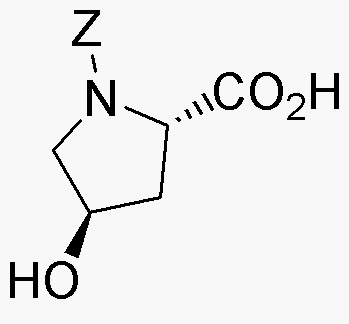Z-L-trans-4-hydroxyproline is widely utilized in research focused on:
- Pharmaceutical Development: This compound serves as a valuable building block in the synthesis of various pharmaceuticals, particularly in the development of drugs targeting collagen-related diseases.
- Biotechnology: It is used in the production of collagen and gelatin, which are essential in tissue engineering and regenerative medicine, offering enhanced biocompatibility compared to other compounds.
- Cosmetic Formulations: Z-L-trans-4-hydroxyproline is incorporated into skincare products for its moisturizing properties, helping to improve skin elasticity and hydration.
- Food Industry: This compound can be used as a food additive to enhance the texture and stability of certain products, providing a healthier alternative to synthetic additives.
- Research in Structural Biology: It plays a crucial role in studying protein structures, particularly in understanding the stability and folding of collagen, which is vital for various biological processes.
General Information
Properties
Safety and Regulations
Applications
Z-L-trans-4-hydroxyproline is widely utilized in research focused on:
- Pharmaceutical Development: This compound serves as a valuable building block in the synthesis of various pharmaceuticals, particularly in the development of drugs targeting collagen-related diseases.
- Biotechnology: It is used in the production of collagen and gelatin, which are essential in tissue engineering and regenerative medicine, offering enhanced biocompatibility compared to other compounds.
- Cosmetic Formulations: Z-L-trans-4-hydroxyproline is incorporated into skincare products for its moisturizing properties, helping to improve skin elasticity and hydration.
- Food Industry: This compound can be used as a food additive to enhance the texture and stability of certain products, providing a healthier alternative to synthetic additives.
- Research in Structural Biology: It plays a crucial role in studying protein structures, particularly in understanding the stability and folding of collagen, which is vital for various biological processes.
Documents
Safety Data Sheets (SDS)
The SDS provides comprehensive safety information on handling, storage, and disposal of the product.
Product Specification (PS)
The PS provides a comprehensive breakdown of the product’s properties, including chemical composition, physical state, purity, and storage requirements. It also details acceptable quality ranges and the product's intended applications.
Certificates of Analysis (COA)
Search for Certificates of Analysis (COA) by entering the products Lot Number. Lot and Batch Numbers can be found on a product’s label following the words ‘Lot’ or ‘Batch’.
*Catalog Number
*Lot Number
Certificates Of Origin (COO)
This COO confirms the country where the product was manufactured, and also details the materials and components used in it and whether it is derived from natural, synthetic, or other specific sources. This certificate may be required for customs, trade, and regulatory compliance.
*Catalog Number
*Lot Number
Safety Data Sheets (SDS)
The SDS provides comprehensive safety information on handling, storage, and disposal of the product.
DownloadProduct Specification (PS)
The PS provides a comprehensive breakdown of the product’s properties, including chemical composition, physical state, purity, and storage requirements. It also details acceptable quality ranges and the product's intended applications.
DownloadCertificates of Analysis (COA)
Search for Certificates of Analysis (COA) by entering the products Lot Number. Lot and Batch Numbers can be found on a product’s label following the words ‘Lot’ or ‘Batch’.
*Catalog Number
*Lot Number
Certificates Of Origin (COO)
This COO confirms the country where the product was manufactured, and also details the materials and components used in it and whether it is derived from natural, synthetic, or other specific sources. This certificate may be required for customs, trade, and regulatory compliance.


